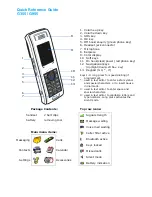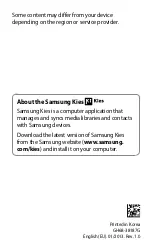
SAMSUNG Proprietary-Contents may change without notice
Circuit Description
2-6
This Document can not be used without Samsung's authorization
7) CSP2200
CSP2200 is integrated the timing and control functions for GSM 2+ mobile application with the ADC and DAC functions,
and power management block. The CSP2200 interfaces to the trident, via a 16-bit parallel interface. It serves as the
interface that connects a DSP to the RF circuitry in a GSM 2+ mobile telephone. DSP can load 148 bits of burst data
into CSP2200
’
s internal register, and program CSP2200
’
s event timing and control register with the exact time to send the
burst. When the timing portion of the event timing and control register matches the internal quarter-bit counter and internal
frame counter, the 148 bits in the internal register are GMSK modulated according to GSM 2+ standards. The resulting
phase information is translated into I and Q differential output voltages that can be connected directly to an RF modulator
at the TXOP and TXON pins. The DSP is notified when the transmission is completed. For receiving baseband data, a
DSP can program CSP2200
’
s event timing and control register with the exact time to start receiving I and Q samples
through TXIP and TXIN pins. When that time is reached, the control portion of the event timing and control register will
start the baseband receive section converting I and Q sample pairs. The samples are stored in a double-buffered register
until the register contains 32 sample pairs. CSP2200 then notifies the DSP which has sample time to read the information
out before the next 32 sample pairs are stored. The voice band ADC converter issues an interrupt to the DSP whenever it
finishes converting a 16-bit PCM word. The DSP then reads the new input sample and simultaneously loads the voice
band output DAC converter with a new PCM output word. The voice band output can be connected directly to a speaker
via AOUTAN and AOUTAP pins and be connected to a Ear-mic speaker via AOUTBN and AOUTBP pins.
There are 7 LDOs which are power sources of microprocessor, LCD, etc. These 7 LDOs output are programmable.











































